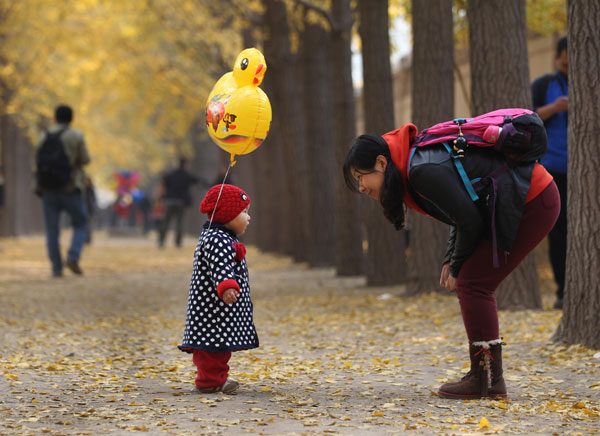Two-child policy projected to add $12b in consumption
Updated: 2015-10-30 13:05
By Dai Tian(chinadaily.com.cn)
|
|||||||||||
 |
|
A woman plays with a girl on a street outside the Diaoyutai State Guesthouse in Beijing on Nov 8, 2013.[Zou Hong/Asianewsphoto] |
The universal two-child policy will likely add an average of 2.5 million newborns per year, unleashing 75 billion yuan ($11.8 billion) in additional consumption, said a scholar of Peking University.
China lifted its more than three-decade-old family planning policy, according to a statement issued on Thursday by the Communist Party of China Central Committee, under which roughly 90 million couples will become eligible to have a second child.
The estimate is based on the prediction that each child brings an average of 30,000 yuan expense each year, Liang Jianzhang, professor of economics at Peking University, told Securities Times. He added that the government is expected to expand its annual infrastructural investment by 225 billion yuan over the next five to 10 years.
The latest move comes amid the nation's changing demographics, which could lead to potential labor shortages in the future if not addressed.
The statement said the China's aging trend would be actively addressed by the national two-child policy, and that it would continue to stick to the family planning policy as a basic State interest.
"This policy change could have a positive impact on demographics, and hence the economic outlook, but any such impact will only crystallize over the long term," Atsi Sheth, associate managing director of Moody’s, noted in a report on Friday.
In late 2013, the government first relaxed the family planning policy, allowing couples to have a second child in situations where one spouse was an only child. However, as of June, only 1.5 million of the 11 million eligible couples had applied to have a second child.
The country has suffered from low fertility rate, with the ratio hitting the bottom at 1.18 in 2010 and only slightly rebounding to 1.24 in 2013, according to the National Bureau of Statistics. A minimum of 2.1 is required to replace an aging population, experts said.
Shan Juan contributed to this story.
Related Stories
Family planning policy sees big overhaul 2015-10-30 06:50
Diaper brands jockey for China's booming market 2015-09-29 15:40
Holidays spark shopping spree 2015-09-23 08:05
Next generation not keen on family businesses, says survey 2015-09-03 11:04
Today's Top News
Russian jet broke up in mid air, too early for conclusions
GDP growth targeted at 6.5 to 7% through 2020
Two-child policy to add $12b in consumption
China to buy Airbus jets in $17b deal
China to allow two children for all couples
China's central bank dismisses QE rumor
Chinese premier holds talks with German chancellor
Refugee crisis continues to create rift between pro-Europeans, Eurosceptics
Hot Topics
Lunar probe , China growth forecasts, Emission rules get tougher, China seen through 'colored lens', International board,
Editor's Picks

|

|

|

|

|

|






